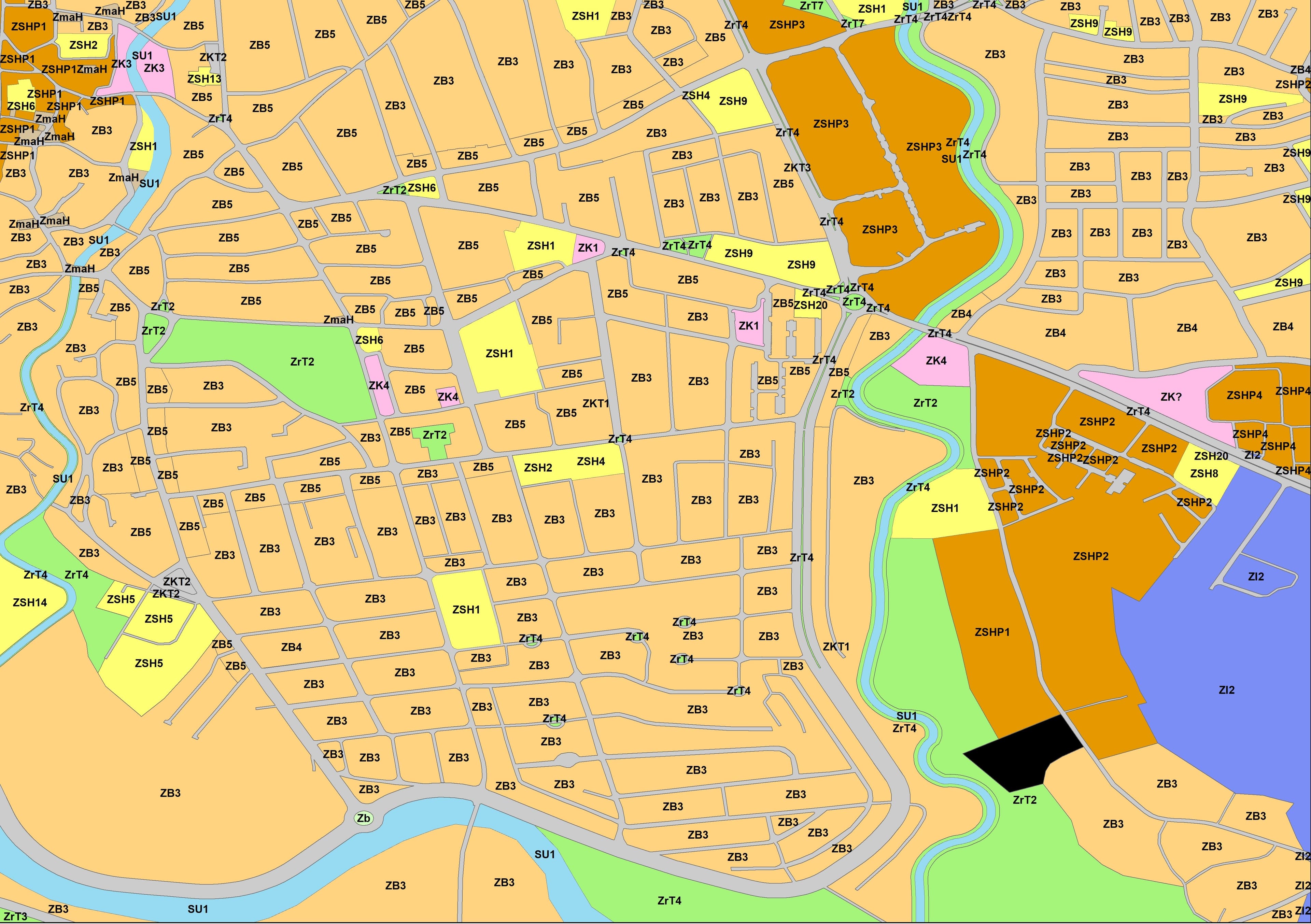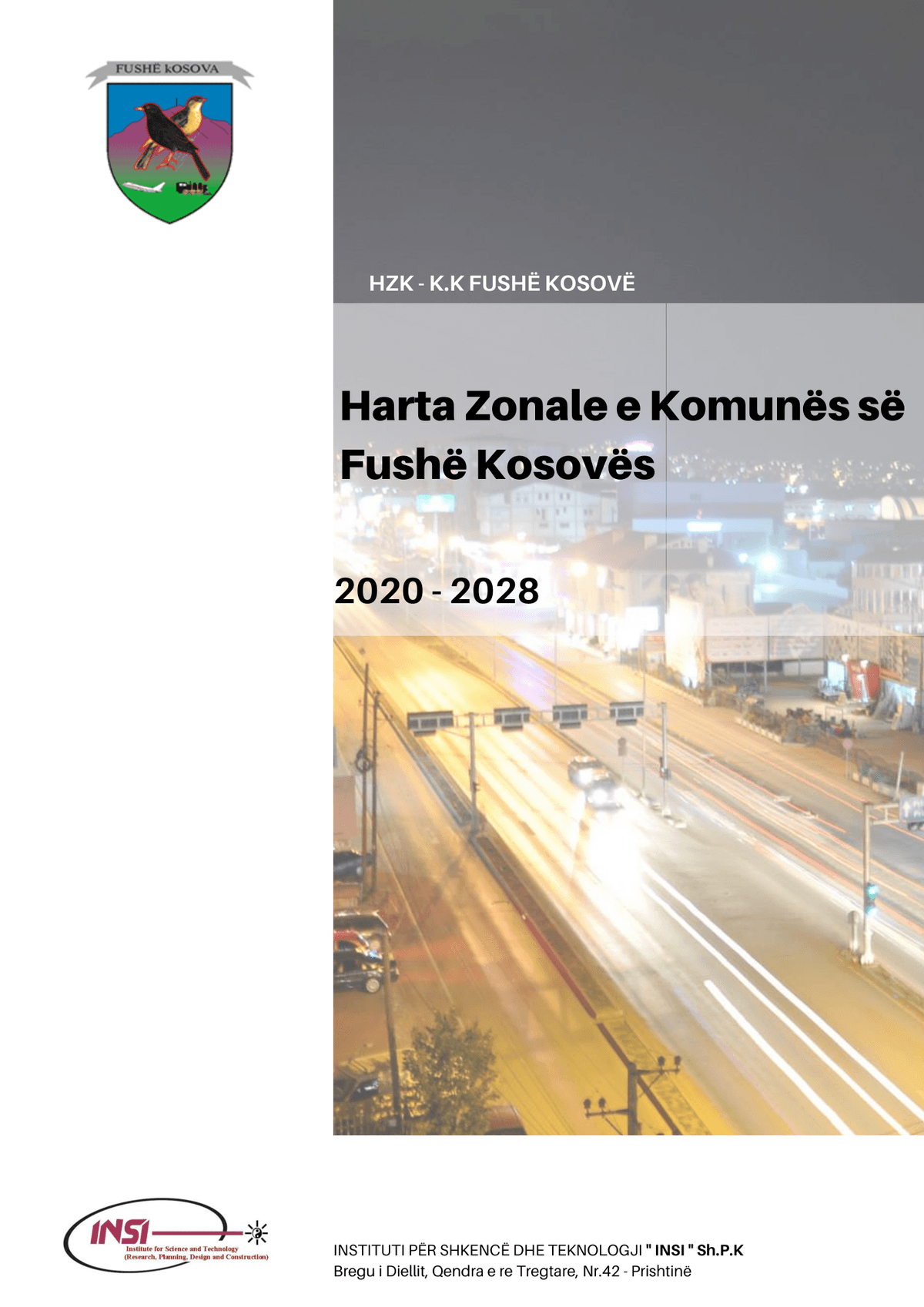
Municipal Zoning Map Of Fushe Kosove
INSI
Municipal Zoning Map Of Fushe Kosove

The Municipal Zoning Map is a multi-sectorial spatial planning document that determines the development conditions of urban and rural areas (villages) within the municipal territory. Throughout this assignment, INSI identifies the appropriate development conditions and measures for future developments including the protection of the environment and existing natural resources, as ll as the underground and overground resources. Furthermore, general development conditions define development regulations and standards that apply to all zones. General development conditions may include but are not limited to, requirements and rules, protection measures, design patterns and guidelines. INSI establishes the uses and development conditions for each zone and the terms of construction that aim to achieve the goals and objectives of the Municipal Development Plan and for their spatial and geographical extension based on its Future Land Use Map and Sectorial Development Plans.
The drafting process has to be compliant with various phases/chapters that address all thematic sectors through textual and cartographic representation, as envisaged by the legislative framework that regulates the drafting process. Based on the principle of democracy, subsidiary, participation, integration, proportionality and prevention, the main drafting phases comprise of:
1. General Development Conditions that define development regulations and standards that apply to all zones. General development conditions may include, but are not limited to, requirements and rules, protection measures, design patterns and guidelines such as land permitted uses, secondary permitted uses, special uses, temporary uses and not permitted uses in the whole Municipal territory, access to the cadastral parcel, access to technical infrastructure, parking and unloading rules, landscape development and buffering rules, natural and artificial lighting design and requirements, and noise mitigation requirements.
2. List of Zones that all the designated zones overlay zones established within the municipal territory within the municipal territory, in accordance with spatial planning technical norms.
3. Defined Zones and Development Conditions that are set in compliance with all spatial planning technical norms and requirements set forth in the Administrative Instruction on the Spatial Database, which specifies permitted uses are those functions and activities which are allowed for the particular zone, permitted secondary uses are those functions and activities which are secondary and subordinate to the primary use permitted in the zone and may be located on the same parcel as the primary use, permitted special uses are those functions and activities which are compatible with permitted uses in the zone but are subject to additional conditions and require a special use permit, temporary uses are those functions and activities which are permitted for a specific period of time, after which they must be completely removed, not permitted uses are those functions and activities which are not in harmony with applicable conditions of the area and are specifically not permitted in the zone. Development conditions also include other specifications of requirements for regulation of the space during setting construction terms, such as maximum dwelling density expressed as a maximum number of dwelling units per hectares (ha), parcel size expressed as a minimum or recommended size of parcel, parcel or parcel frontage minimum size, parcel or parcel frontage maximum size, architectural and aesthetic characteristics of certain elements of buildings (such as materials, facades, roofs, etc.), developing rules for landscaping and green buffer zones, off-street parking and shared parking, and minimum and maximum permitted height of buildings within the zone or part of a zone.
4. Overlay Zone Development Conditions that defines complementary development conditions and terms of construction within a specific area of a municipality that requires special attention by determining protective measures for cultural, historic, economic, touristic, agricultural resources that are not addressed by base zone, protective and preventive measures are set for protected areas, Special Zones and Special Protected Zones, and Protected Zones, protective measures for natural local resources, such as protection of nature, water areas, climate, forests, etc., that are not addressed by base zone, protective measures for impact on the environment, such as; air pollution, noise, etc, protective and preventive measures are set for fire, flooding danger areas, seismic, erosive areas, rolling rock, earthquake areas and others, and certain standards that are not necessary to apply throughout the municipality.
5. Road Infrastructure Development Conditions that specifiesthe type, area, capacity, and technical conditions for design and construction of roads, motorized and non-motorized, with categorization and levels, rail network, light and heavy, buildings and areas for air transport, buildings and areas for urban and rural public transport, and public parking areas.
6. Public and Social Infrastructure Development Conditions that specifies the type, location, capacity, and technical conditions for design and construction of public parks and open spaces, sport fields and recreational areas, medical service areas and buildings, social service buildings, daycare buildings, schools and universities, administrative centres, public safety areas and buildings, and cemeteries.
7. Technical Infrastructure Development Conditions that specify capacity and network, auxiliary facilities, buffer zones and equipment for water supply system, sewage system, wastewater treatment plants, drainage systems, irrigation network, local thermal energy distribution, local electricity supply, telecommunication network and other similar installations, waste disposal sites and landfills, recycling and composting facilities, and buildings and space for recycling and decomposition.
8. Treatment of Informal Settlements that determines development conditions that are applicable according to the legislation in force.
9. Detailed Regulatory Plans to Be Drafted that specifythe boundaries of those areas that will be subject to Detailed Regulatory Plans, which would supplement but may not alter the terms of the Municipal Zoning Map and after a Detailed Regulatory Plan is approved, Municipal Zoning Map shall be updated with any additional development conditions and cartographic information added by the Detailed Regulatory Plan.
10. Implementation Action Plan that specifiesactivities planned in the Action Plan of the Municipal Development Plan through the development of concrete projects for transport, technical, public and social infrastructure networks set for each subsequent year the designated placement, including eventual expropriation, approximate implementation cost, anticipated source(s) of financing, implementation period, and institutions responsible for implementation.
11. Administration, Implementation and Monitoring of Implementation that describes the procedures and responsibilities for zoning related tasks, including review of zoning compliance, issuing building permits and zoning decisions, interpretations of uses and development conditions, issuing decisions on requests for amendments and exceptions, and process for appeals.
12. Zoning Bonuses that could be applied to increase open space or green areas, provide traffic and pedestrian movement improvements, preserve cultural and historic areas, preserve agricultural land, create public and social building and facilities that benefit the community, integrate and improve informal settlements or provide other amenities desired by the municipality and consistent with its Municipal Development Plan, through reductions in building setback requirements, reductions or waivers of permit fees or infrastructure charges, reduction of the condition in minimum parcel area, width or depth, increased percentage of the footprint area use compared to a cadastral parcel, increased maximum building height and floors, increased density, and incentives proposed by the developer or the municipality to integrate and improve informal settlements.
13. Cartographic Section that is presented to the public shall be based on the most recent official cadastral, orthophoto, aerial, and topographic maps, consisting of Informational Base Map, Map of Areas and Buildings of Importance for Kosovo, Land Use Zoning Map, Agro-Ecological Zoning Map, Agricultural Land Irrigation Systems Map, Manner of Agricultural of Use of The Land Map, Map of Road Infrastructure, Public and Social Infrastructure Maps, Technical Infrastructure Maps, Overlay Zones Map, Informal Settlements Map, and Regulatory Plans Map
14. Implementing and Monitoring that sets out cost projections for implementation to the department of budget and finance to be considered in accordance with procedures for inclusion in the next year’s budget and monitoring of the implementation on an annual basis based on the number of construction permits and certificates of occupancy issued according to construction category, endangered environment status, the level of productivity, the level of increase in quality of public and social services, the level of increase in quality of transport and technical services, the percentage of implemented public and public-private capital investments, as planned for the respective year for the construction of technical, social and public infrastructure, the level of large planned private investments, if known, agricultural household survey, and reviewing the amount of content and extent of amendments applications, zoning exceptions and bonuses.









